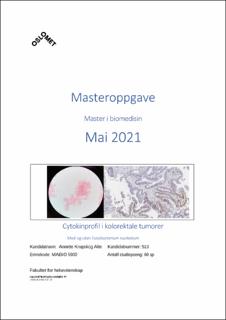| dc.description.abstract | Bakgrunn og formål: Den vanlige oppfatningen er at inflammasjon i kolorektal kreft (CRC) er et resultat av den neoplastiske celleveksten. Det er vist at epitelbarrieren mot tarmlumen kan være svekket i kolorektale tumorer, dette kan føre til infeksjoner av opportunistiske bakterier. Det kan tenkes at bakterier som finnes i tumorens mikromiljø kan forme immunresponsen i CRC. I denne oppgaven er det studert uttrykk av cytokiner som representerer forskjellige typer immunrespons i tumorvev og ikke-neoplastisk vev fra pasienter med CRC. Hypotesen er at Fusobacterium nucleatum påvirker og promoterer tumorigenese ved å opprettholde en lokal kronisk inflammasjon. Et innblikk ønskes i om ikke-neoplastisk vev viser tegn på inflammasjon, og om noen av cytokinene er så høyt i tumor at de kan vurderes som ikke-invasive markører. Det er også ønskelig å finne ut om immunresponsen har utviklet seg ulikt i ulike tumorer. Materiale og metoder: Biopsier fra 25 adenokarsinomer er sammenlignet med biopsier fra marginalsone fra de samme 25 pasientene. Biopsiene er fra en REK-godkjent forskningsbiobank fra Akershus Universitetssykehus. Marginalsone utgjør et område utenfor tumor, hvor det ikke er funnet neoplastisk vekst. Referansegener og primere ble evaluert og analyser optimalisert før RT-qPCR med SYBR Green ble utført på 50 prøver i duplikat for cytokinene IL-6, IL-12, IL-17, IL-23, TGF-β, TNF- - og IFN-ℽ. Relativt genuttrykk av mRNA ble beregnet med 2-Ct -metode. Uttrykk av IL-6 og pSTAT3 ble undersøkt på 25 formalinfiksert parafininnstøpte tumorbiopsier fra de samme pasientene ved bruk av immunhistokjemi (IHC). Resultater: Pro-inflammatoriske IL-6, IL-23, og IL-17 var signifikant høyere uttrykt i tumorprøvene sammenliknet med marginalsone. Dette gjaldt også IFN-ℽ. IL-12 var ikke signifikant forhøyet i tumor, og hadde mindre uttrykk i tumor enn marginalsone i 8 prøver. TGF-β var høyt uttrykt i marginalsone, og noe forhøyet i tumor. IHC viste at IL-6 og pSTAT3 var høyt uttrykt i tumorceller. Det ble funnet høyere uttrykk av både IL-6 og IL-23 i prøver med Fusobacterium nucleatum funn i kolon, men disse forskjellene var ikke statistisk signifikante. Konklusjon: Tumorvevet domineres av et pro-inflammatorisk miljø med mye genuttrykk av IL-6, IL 23 og IL-17. Ettersom genuttrykket av IL-6 var høyt i tumor og IHC viste at det var mest uttrykt i selve tumorcellene, kan IL-6 vurderes som mulig ikke-invasiv markører for kolorektal kreft. Det er også vist en tendens til at både IL-6 og IL-23 er høyere uttrykt i prøver som har funn av Fusobacterium nucleatum i kolon, men det krever videre forskning. TGF-β er et pleiotropisk cytokin med flere effekter innen immun-regulering og tumorutvikling og da cytokinet var høyt uttrykt i marginalsone, var det vanskelig å vurdere effekten innenfor hver prøve og lokalisasjon. Det kreves mer forskning på både signalvei og celletyper som kan påvirkes av cytokinet. Det var tegn på at immunresponsen utvikler seg ulikt i ulike tumorer med prøver med høye og lave nivåer av IFN-γ, i tillegg til funn av høye nivåer av cytokiner som kan øke tumorigenesen hos andre prøver.
Background and aim: It is commonly thought that inflammation is a response to the neoplastic cell growth in colorectal cancer. Former studies have shown that the epithelial barrier may be weakened in CRC creating an opportunity for pathogenic bacteria to invade and create infection within the microenvironment. The presence of bacteria in the tumor microenvironment may possibly trigger and shape the immune response. The current work has studied the expression of cytokines that represent different responses by the immune system in both tumor tissue and non-neoplastic tissue from a selection of patients diagnosed with CRC. One hypothesis is that Fusobacterium nucleatum influence and promotes tumorigenesis by creating and maintaining a local chronic inflammation. One aim of this study is to see if the non-tumor tissue has signs of inflammation, and to identify possible candidates for non-invasive biomarkers of CRC. Another aim is to study the diversity of the immune response by analyzing the expression of different cytokines. Materials and methods: The material of this study consisted of 25 adenomacarcinoma biopsies, which were compared to 25 biopsies from non-neoplastical zones collected within the same patients. The project is approved by The Regional Ethics Community and the samples are part of a biobank established at the Akershus University Hospital, Norway. A selection study was conducted on suited reference genes and primer design for IL-6, IL-12, IL-17, IL-23, TGF-β, TNF- and IFN-ℽ was performed. RT followed by SYBR Green qPCR was conducted on 50 duplicated samples, specificity and efficiency was measured and corrected using Tm analysis and LinReg software before quantification by using the 2-Ct method. IHC analysis of anti-IL-6 and anti-pSTAT3 was performed on FFPE sections from CRC tumours. Results and conclusion: Expression of IL-6, IL-23 and IL-17 was significantly (p<0,005) increased in tumours. IHC also showed that both IL-6 and pSTAT3 was highly expressed by neoplastic cells within the tumor tissue, pointing to IL-6 as a potential candidate for a non-invasive biomarker. IFN-ℽ and TGF-β were also significantly higher expressed in tumours, but TGF-β was also highly expressed in the non-neoplastical zone. These findings require more research regarding cellular location and biological effects of TGF-β. IL-12 was not significantly increased in tumours (p=0,065) and 8 samples showed more expression in the non-neoplastical zone. There was a tendency towards higher expression of both IL-6 and IL-23 in samples with F. nucleatum, but the differences were not significant. More research is required to establish a potential link between cytokine expression and F. nucelatum. The biobank consists of CRC samples from different cancer stages and several of the samples showed diversities in their immune profile, showing samples with low and high expression of immune regulating cytokines. Several of these cytokines have previously been shown to promote tumor growth and survival. | en_US |
